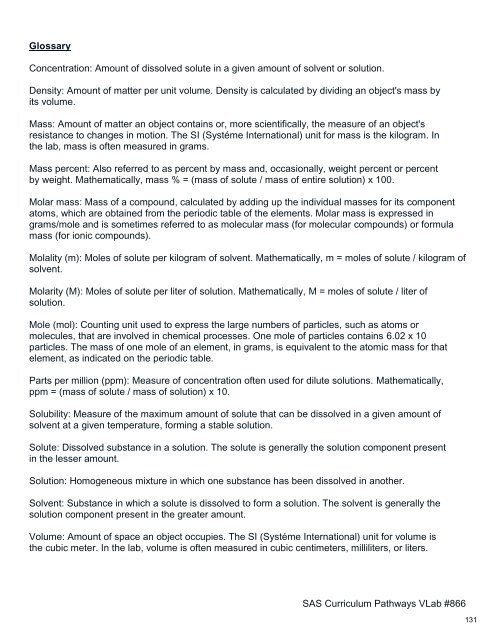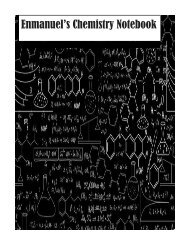You also want an ePaper? Increase the reach of your titles
YUMPU automatically turns print PDFs into web optimized ePapers that Google loves.
Glossary<br />
Concentration: Amount of dissolved solute in a given amount of solvent or solution.<br />
Density: Amount of matter per unit volume. Density is calculated by dividing an object's mass by<br />
its volume.<br />
Mass: Amount of matter an object contains or, more scientifically, the measure of an object's<br />
resistance to changes in motion. The SI (Systéme International) unit for mass is the kilogram. In<br />
the lab, mass is often measured in grams.<br />
Mass percent: Also referred to as percent by mass and, occasionally, weight percent or percent<br />
by weight. Mathematically, mass % = (mass of solute / mass of entire solution) x 100.<br />
Molar mass: Mass of a compound, calculated by adding up the individual masses for its component<br />
atoms, which are obtained from the periodic table of the elements. Molar mass is expressed in<br />
grams/mole and is sometimes referred to as molecular mass (for molecular compounds) or formula<br />
mass (for ionic compounds).<br />
Molality (m): Moles of solute per kilogram of solvent. Mathematically, m = moles of solute / kilogram of<br />
solvent.<br />
Molarity (M): Moles of solute per liter of solution. Mathematically, M = moles of solute / liter of<br />
solution.<br />
Mole (mol): Counting unit used to express the large numbers of particles, such as atoms or<br />
molecules, that are involved in chemical processes. One mole of particles contains 6.02 x 10<br />
particles. The mass of one mole of an element, in grams, is equivalent to the atomic mass for that<br />
element, as indicated on the periodic table.<br />
Parts per million (ppm): Measure of concentration often used for dilute solutions. Mathematically,<br />
ppm = (mass of solute / mass of solution) x 10.<br />
Solubility: Measure of the maximum amount of solute that can be dissolved in a given amount of<br />
solvent at a given temperature, forming a stable solution.<br />
Solute: Dissolved substance in a solution. The solute is generally the solution component present<br />
in the lesser amount.<br />
Solution: Homogeneous mixture in which one substance has been dissolved in another.<br />
Solvent: Substance in which a solute is dissolved to form a solution. The solvent is generally the<br />
solution component present in the greater amount.<br />
Volume: Amount of space an object occupies. The SI (Systéme International) unit for volume is<br />
the cubic meter. In the lab, volume is often measured in cubic centimeters, milliliters, or liters.<br />
SAS Curriculum Pathways VLab #866




